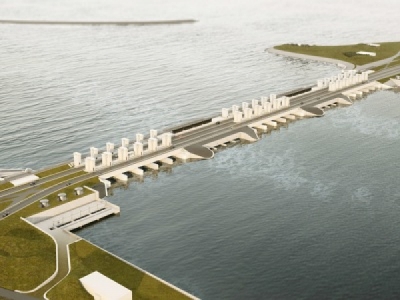
Posted on April 26, 2018
Innovative concrete blocks. Natural discharge if possible, pumping if necessary. An opening for a fish migration river. These are just a few of the innovations for the Afsluitdijk in the next few years.
Together with Levvel – a consortium comprising Van Oord, BAM, and Rebel – Rijkswaterstaat (part of the Dutch Ministry of Infrastructure and the Environment and responsible for the design, construction, management and maintenance of the main infrastructure facilities in the Netherlands) will launch the project at the end of 2018. On Monday 23 April 2018, the Rijkswaterstaat and Levvel presented the designs to the media and to a large group of stakeholders who have been closely involved in planning in the past few years.
On the Wadden Sea side, the causeway will be raised and reinforced with new facing. For this work, the consortium will use ‘Levvel blocks’, innovative concrete elements that have been developed specially for the Afsluitdijk. Each block weighs about 6,500 kg, is extremely strong, has a wave retardant effect, and is easy to install. Some 100 blocks a day will be produced by means of a fully automated process in the port of Harlingen and transported by ship to the causeway. A pontoon crane will then be used to position the blocks, 75,000 in all. Because of their symmetry and the regular way they are positioned, the blocks have a tranquil appearance that reinforces the austere and autonomous character of the causeway. To protect the hinterland from the force of the water, the drainage locks will also be reinforced and two storm-surge barriers will be built.
The drainage locks at Den Oever will be expanded with new locks in between the island sections. This will allow more of the water that enters the IJsselmeer from the River IJssel to be discharged into the Wadden Sea. If the water level in the Wadden Sea is high, then natural drainage is no longer possible. Levvel is therefore building two large pumping stations in Den Oever. The pumps will operate with very low energy consumption and are fish-friendly. They will be powered sustainably by 2.7 hectares of solar panels near Den Oever. With these measures, Rijkswaterstaat and Levvel will ensure that the Afsluitdijk can again withstand the force of the water until at least 2050.
In order to restore the connection between the Wadden Sea and the IJsselmeer for migratory fish, a fish migration river will be constructed by ‘The New Afsluitdijk’, a partnership between the provinces of Friesland and Noord-Holland and the municipalities of Súdwest-Fryslân, Hollands Kroon, and Harlingen. This will be a 4 km channel surrounded by an ecological area accessible to visitors. Levvel will construct the necessary opening in the Afsluitdijk for the fish migration river.
The Afsluitdijk was constructed largely by manpower, with some 5,000 workers positioning the basalt blocks one by one. And today also, work on the causeway will continue to create employment, with some 800 people working on and around it in the peak period. Levvel is creating sustainable employment by filling about 100 of the jobs with jobseekers whose job prospects are relatively poor.
The Afsluitdijk is a necessary construction, a protective barrier against the sea and a road link between two provinces. At the same time, it is a unique area much visited by tourists. To improve facilities for visitors, the New Afsluitdijk partnership has developed a number of initiatives that Rijkswaterstaat has included in the assignment issued to Levvel. For example, there will be an additional cycle path along the full length of the dike on the Wadden Sea side. The area around the striking monument designed by Willem Dudok will be upgraded and made more accessible to the public. The present pedestrian bridge will be relocated so as to reinforce the vertical character of the monument (a unique feature on the dike). At Kornwerderzand there will soon be a new walking trail allowing people to access the fish migration river.
The New Afsluitdijk partnership has also developed the Afsluitdijk Wadden Centre, which was opened in March this year by the Minister of Infrastructure and Water Management, Cora van Nieuwenhuizen, and the Friesland Executive Councillor Klaas Kielstra. The centre offers a comprehensive look at the history and future of the Afsluitdijk and the Wadden Sea. It also has good catering facilities, with a waterside terrace. Visitors to the centre can keep close track of the large-scale work to improve the dike by means of drone imaging, animations, models, and photos. While construction is going on, Levvel will also be organising boat excursions from the Centre so as to give those interested an insight into the production and installation of the Levvel blocks.
Work on the Afsluitdijk is expected to start in late 2018 and continue until the end of 2022.
Source: Van Oord





